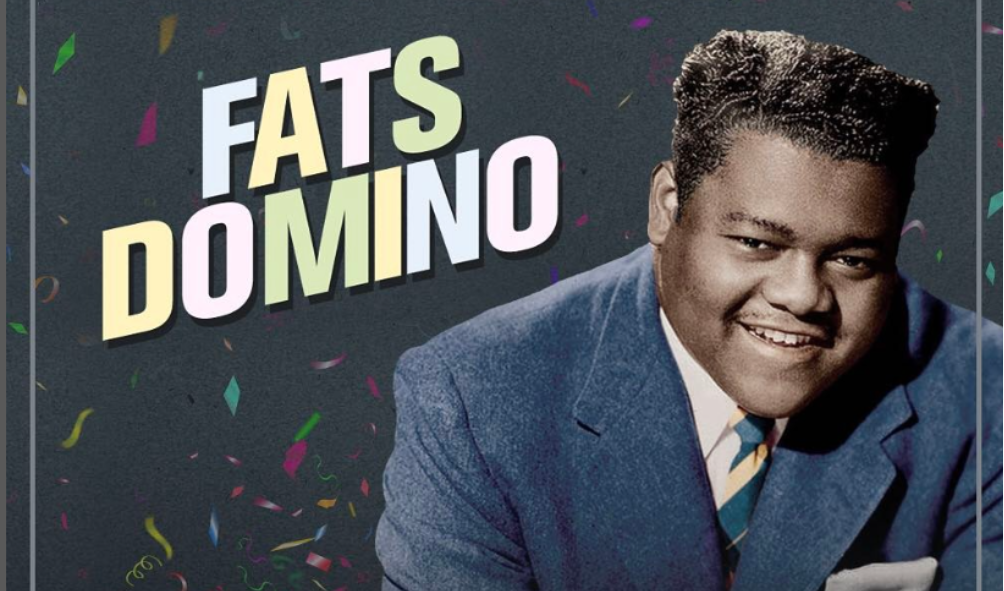Fats Domino, whose real name was Antoine Dominique Domino Jr., was a constant in the music business in addition to being a pianist and singer. In addition to being a rock and roll pioneer and a mainstay of rhythm and blues, Domino was well-liked in his own New Orleans. His impact may be seen everywhere. His infectious energy, humorous lyrics, and captivating piano riffs left a lasting influence on the music business and served as an inspiration to a new generation of musicians.
From the National Stage to the Ninth Ward
Born in the bustling Ninth Ward of New Orleans in 1928, Fats Domino was exposed to music from an early age. When he was younger, he started to play the piano and would practice at neighborhood honky-tonks. He got to know bandleader and record producer Dave Bartholomew while he was employed at a factory. They would continue to work together for the rest of their lives. Domino signed with Imperial Records in 1949, the same year that their breakout hit, “The Fat Man,” went viral. With its infectious tempo, great Domino vocals, and brilliant Bartholomew production, “The Fat Man” shot to fame, selling over a million copies and earning praise as one of the original rock and roll hits.
A Smiling Hit Machine
In the 1950s and 1960s, Domino produced several singles that will never be forgotten. His distinctive style, which combines lively narration, catchy piano melodies, and a rhythm section that virtually begs you to move, was on full display in songs like “Ain’t That a Shame,” “Blueberry Hill,” and “Walking to New Orleans”. Domino’s music broke over racial boundaries, appearing on the rising pop and rhythm & blues charts alike. His songs embodied the joy of life, the thrill of a night out, and the basic joys of a good time; they were more than just great tunes.
The Sound of New Orleans and Beyond
Fats Domino’s music drew heavily from the rich musical gumbo of New Orleans. The city’s unique blend of African, French, and Caribbean components is reflected in his sharp piano lines, syncopated rhythms, and brassy orchestration. He was not merely a performer; he was the global face of the New Orleans sound, bringing its energy and passion to listeners everywhere.
A Significant Legacy
The influence of Fats Domino on rock & roll cannot be disputed. Little Richard, Elvis Presley, Jerry Lee Lewis, and other notable figures acknowledged his impact, and musicians are still inspired by his songs today. Numerous generations have been impacted by him, including The Beatles, who covered “Ain’t That a Shame,” and Elton John, who cited Domino as one of his main sources of inspiration.
Not Only Musical
Beyond his artistic prowess, Domino embodied perseverance and joy. He never lost touch with his New Orleans roots, even after becoming well-known both domestically and abroad. He was well-liked and well-known for his cheerful and friendly disposition in his area.
A Life Well Spent
Fats Domino, who passed away in 2017 at the age of 89, left behind a legacy that will last for a very long time. He was an entertainer who brought joy to millions of people, a trailblazer, an inventor, and a true titan of American music.
Unintentional Integration: Racial Barriers and Fats Domino
The influence of Fats Domino on music went beyond memorable songs. His popularity, especially with white audiences, contributed subtly but significantly to the dismantling of racial barriers in the 1950s-segregated United States.
Using Beats to Shatter Walls
There was an indisputable allure to Fats Domino’s music that cut beyond racial boundaries. Black and white teenagers alike were captivated by the contagious energy emanating from his music. A spectacle that was previously unthinkable in the segregated South, concerts transformed into melting pots where crowds danced together. This cross-cultural interaction wasn’t always easy. Due to racial tensions created by merged crowds, there were riots at certain concerts. Still, the groundwork for change was laid.
An Object to the Current Situation
Fats Domino defied racial stereotypes at the time with his success as a black performer on the pop charts. White America was obliged to acknowledge a black musician’s skill and artistry. For other black musicians like Little Richard and Chuck Berry, this in turn created opportunities. Although Elvis Presley would go on to become an iconic figure in rock & roll, Domino’s impact helped create a more varied scene.
The Cost of Notoriety
Even with his widespread fame, segregation remained a reality for Domino. While on tour, he and his band encountered discrimination; they were made to stay in motels with separate amenities and utilize separate rooms. The sharp discrepancy between his stage image and real life outside of the theater brought to light the absurdity of America’s segregated society.
An Icon of Hope
Fats Domino spread a message of harmony and hope via his music and his everlasting grin. His songs honored the small pleasures in life, topics that appealed to listeners of many ethnicities. His music created a feeling of shared experience through the universal language of music during a period of racial divide.
The Aftereffects of Integration
Fats Domino was a major factor in the racial integration movement, even though his influence cannot be fully attributed to him. Young people of many races were able to bond through his songs. The Civil Rights Movement of the 1960s was founded on this cross-cultural exchange, which was propelled by the power of music.
Beyond the Hits: Examining Domino’s Songbook in More Detail
A wealth of memorable songs, each with a unique backstory, can be found throughout Fats Domino’s discography. Here are a few instances:
- “The Fat Man” (1949): Known for its upbeat lyrics and intense beat, this ground-breaking song is regarded as one of the original rock and roll records.
- “Ain’t That a Shame” (1955): A lighthearted wink and a story of a love gone bad, this chart-topping single demonstrates Domino’s storytelling prowess.
- “Blueberry Hill” (1956): A pop staple covered by Domino, who gave the song a fresh sound and made it his biggest hit.
- The 1960 film “Walking to New Orleans”: With its brassy overtones and irregular rhythms, the song is a sentimental tribute to Domino’s favorite birthplace, capturing the exuberant essence of the city.
We can better understand Domino’s compositional abilities, lyrical humor, and capacity to emotionally engage listeners by digging further into these tracks.
The Lasting Domino: Later Profession and Heritage
Domino’s career continued far into the 1980s, even though his public fame peaked in the 1950s and 1960s. He was still a popular traveling act, and his passionate performances were a tribute to his undying love of music.
An Up-and-Coming Fan Base
Musicians of all genres have continued to be inspired by Domino. Many musicians have included his music in their repertoires and hearts, ranging from modern performers like Bruce Springsteen and Dr. John to legendary rock outfits like The Who and Elton John.
Beyond Music
Domino was a cultural figure in addition to a musician. His contagious energy, distinct smile, and grounded demeanor won him admirers across the globe. He personified the essence of New Orleans, a city renowned for its tenacity and joie de vivre.
A Durable Effect
Beyond his number-one hits and platinum record sales, Fats Domino left behind a lasting legacy. He was a beloved part of his neighborhood, a trailblazer of rock & roll, and a representation of racial integration. His music has influenced countless musicians and music lovers throughout the years, and it also promotes happiness and intercultural understanding.

